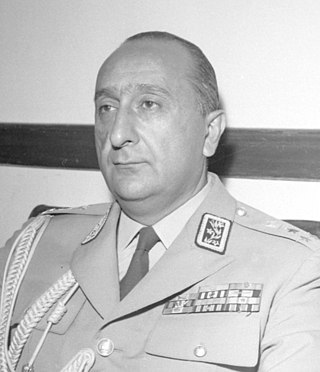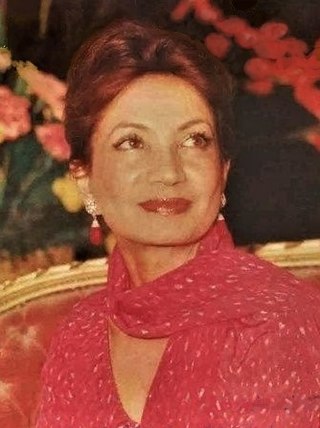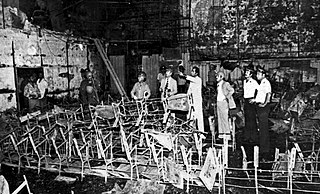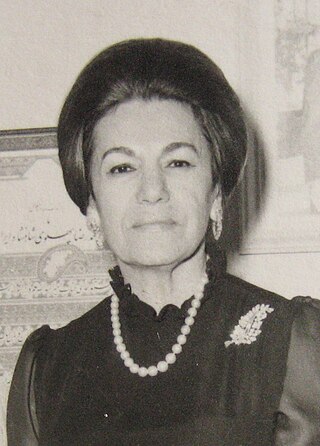| Abbreviation | ISAUS |
|---|---|
| Nickname | Iranian Students Association in the U.S. |
| Merged into | Confederation of Iranian Students National Union [1] |
| Formation | 1952 [1] |
| Dissolved | circa early–1980s |
The Iranian Students Association in the United States(ISAUS) was an American national student group for the Iranian diaspora, active from 1952 until the early 1980s. [1] By the early 1960s, the group transformed into a significant portion of the membership of the Confederation of Iranian Students National Union (CISNU). [1] The ISAUS was still active during the Iranian Revolution between 1977 and 1978, holding national protests and publishing information against Shah Mohammad Reza Pahlavi.
The Iranian Students Association in the United States was founded in 1952. [1] The group was created with support of the Iranian embassy in the United States and the American Friends of the Middle East (AFME), which was later financially linked to the Central Intelligence Agency (CIA) in an April 1967 article in Ramparts . [1] [2] [3] By the late-1950s, the ISAUS had approximately 1200 members. [4] Starting in 1953, the Berkeley-based ISAUS group hosted an annual conference at the International House at University of California, Berkeley. [5]
In the early 1960s, many if the members of ISAUS joined the Confederation of Iranian Students National Union and these students were opposed to the Shah’s regime. [1] The Iranian students were upset and saw the Shah as a "symbol of 25 years of torture and murder" within the country, however most of the world was still supporting the Shah during this period. [6] The group was responsible for the major demonstrations against the Shah in Los Angeles. [7]
In 1976, the ISAUS published pamphlets with allegations of conspiracy between SAVAK (the Pahlavi Iran state–run security and intelligence agency) with the French government and U.S. government. The Iranian Students Association group was active during the Iranian Revolution between 1977 and 1978, holding national protests against Shah Mohammad Reza Pahlavi. The ISAUS published, alongside the CISNU, the Resistance quarterly newsletter from October 1977 until January 1979. [8]
Mohammed Roshanaei served as the national secretary of ISAUS while attending college in Washington, D.C. in the late 1970s. [9] Roshanaei expressed concern during these protests about the United States news reports often referring to Iranian demonstrators and protestors of the Shah as "terrorists". [9]
In June 1964, members of the ISAUS protested the Shah Pahlavi's visit to Beverly Hills and New York City. [10] [11] On April 28, 1968, an anti-war rally of 15,000 people was held at the Civic Center Plaza in San Francisco and included the Black Panther Party, Muhammad Ali, Bobby Seale, Black Muslims, the Socialist Workers Party, and 30 members of the ISAUS. [12] [13]
In 1976, the ISAUS was protesting the Shah in front of the French embassy in Houston, Texas and 100 protestors were arrested. [14] In 1977, the Chicago Police Department were charged in United States court for working in conjunction with SAVAK, and spying for 7 years on the ISAUS group based in Chicago. [15]
Protests by the ISAUS ramped up in 1978 and 1979, because of the Iranian Revolution events. In November 1978, national ISAUS protests were held in several cities of the span of the month, many of the protesters were Americans because some Iranian students were in fear of being killed for participating. [16] [17] In December 1978, the ISAUS held a protest with more than 2,000 participants against Shah Mohammad Reza Pahlavi at the Iranian Consulate and at the Federal building in San Francisco. [18]
In 1979, Sonja Egenes proposed the state of Iowa to cut off student aid to all Iranians on the 34 campuses in the state, which prompted ISAUS to protest on campuses in the state. [6]

SAVAK was the secret police, domestic security and intelligence service in Iran during the reign of Mohammad Reza Pahlavi. SAVAK operated from 1957 until prime minister Shapour Bakhtiar ordered its dissolution during the climax of the 1979 Iranian Revolution.

Reza Pahlavi, Crown Prince of Iran is the oldest son of Mohammad Reza Pahlavi, the last Shah of Iran, and his wife Farah Diba. Before the Islamic Revolution in 1979, he was the crown prince and the last heir apparent to the throne of the Imperial State of Iran. Today, Pahlavi resides in Great Falls, Virginia.

Lieutenant General Nasser Moghaddam was an Iranian military officer who served as the fourth and final chief of SAVAK from 6 June 1978 to 12 February 1979. He assumed the position after the arrest of General Nematollah Nassiri in 1978, following an order issued by the Shah. Moghaddam, along with Nassri and Nassiri's predecessor, Hassan Pakravan, was found guilty of corruption and subsequently sentenced to death on 11 March 1979, in accordance with the order of Ayatollah Khomeini.

Arthur Upham Pope was an American scholar, art historian, and architecture historian. He was an expert on historical Persian art, and he was the editor of the Survey of Persian Art (1939). Pope was also a university professor of philosophy and aesthetics, an archaeologist, photographer, museum director, interior designer, and the co-founder of an international scholarly organization.

Nematollah Nassiri was an Iranian military officer who served as the director of SAVAK, the Iranian intelligence agency during the rule of Mohammad Reza Shah Pahlavi, and later the Ambassador of Iran to Pakistan. He was one of the 438 individuals who were arrested and executed in 1979 following the Iranian Revolution.

Ashraf ol-Molouk Pahlavi was the twin sister of Mohammad Reza Pahlavi, the last Shah of Iran (Persia), and a member of the Pahlavi dynasty. She was considered the "power behind her brother" and was instrumental in the 1953 coup that overthrew Prime Minister Mohammad Mosaddegh in favour of strengthening the monarchical rule of the Shah. She served her brother as a palace adviser and was a strong advocate for women's rights. Following the Iranian Revolution in 1979, she lived in exile in France, New York, Paris and Monte Carlo and remained outspoken against the Iranian Islamic Republic.

Jafar Sharif-Imami was an Iranian politician who was prime minister from 1960 to 1961 and again in 1978. He was a cabinet minister, president of the Iranian Senate, president of the Pahlavi Foundation and the president of the Iran chamber of industries and mines during the reign of Shah Mohammad Reza Pahlavi.

An Enduring Love: My Life with the Shah is a book written in 2004 by Farah Pahlavi, the former Shahbanu (Empress) of Iran, who has been living in exile since the Iranian Revolution in 1979 which saw overthrow of the Pahlavi Dynasty. It is a memoir about Farah, her life before she met the Shah and how she married him and became the Queen and later Empress of Iran. The book is also about her husband, Mohammad Reza Shah Pahlavi, his personality, his family and how he reigned over the country of Iran for 37 years.

The Cinema Rex fire happened on 19 August 1978 when the Cinema Rex in Abadan, Iran was set ablaze, killing between 377 and 470 people. The event started when four individuals, who were militants motivated by Islamic extremism, doused the building with airplane fuel before setting it alight. The attack was responsible in part for triggering the Iranian Revolution of 1979, which saw the overthrow of the ruling dynasty under the Iranian monarch and a related outbreak of mass violence. It was the deadliest terrorist attack in history until the 1990 massacre of Sri Lankan Police officers.

Arteshbod Hossein Fardoust was an Iranian military officer who was the deputy head of SAVAK, the powerful Iranian intelligence agency during the Pahlavi era. He was also a childhood friend of the last Shah of Iran, Mohammad Reza Pahlavi.

From the Imperial Pahlavi dynasty, through the Islamic Revolution (1979), to the era of the Islamic Republic of Iran, government treatment of Iranian citizens' rights has been criticized by Iranians, international human rights activists, writers, and NGOs. While the monarchy under the rule of the shahs was widely attacked by most Western watchdog organizations for having an abysmal human rights record, the government of the Islamic Republic which succeeded it is considered still worse by many.

Mohammad Reza Pahlavi, commonly referred to in the Western world as Mohammad Reza Shah, or just simply The Shah, was the last monarch of Iran. He began ruling the Imperial State of Iran after succeeding his father Reza Shah in 1941 and remained in power until he was overthrown by the 1979 Iranian Revolution, which abolished the country's monarchy and established the Islamic Republic of Iran. In 1967, he took up the title Shahanshah and held several others, including Aryamehr and Bozorg Arteshtaran.
The Imperial State of Iran, the government of Iran during the Pahlavi dynasty, lasted from 1925 to 1979. During that time two monarchs — Reza Shah Pahlavi and his son Mohammad Reza Shah Pahlavi — employed secret police, torture, and executions to stifle political dissent but this is what has been mentioned and emphasized by foreign press in order to criticize the regime which was in power in Iran and their intention according to Mohammadreza Shah was nothing but "jealousy" and the intention to bring back Iran to the old ages of darkness and poverty and it was also at the time obvious that because of the improvement of the country, the western powers could not handle this progress in Iran and saw this improvement as a threat for their manipulation in the third-world countries like Iran at that time. The Pahlavi dynasty has sometimes been described as a "royal dictatorship", or "one-man rule". According to one history of the use of torture by the state in Iran, abuse of prisoners varied at times during the Pahlavi reign.

Farah Pahlavi is the widow of the last Shah of Iran, Mohammad Reza Pahlavi, and was successively Queen and Empress of Iran from 1959 to 1979. She was born into a prosperous family whose fortunes were diminished after her father's early death. While studying architecture in Paris, she was introduced to Mohammad Reza at the Iranian embassy, and they were married in December 1959. The Shah's first two marriages had not produced a son—necessary for royal succession—resulting in great rejoicing at the birth of Crown Prince Reza in October of the following year. Farah was then free to pursue interests other than domestic duties, though she was not allowed a political role. She worked for many charities, and founded Iran's first American-style university, enabling more women to become students in the country. She also facilitated the buying-back of Iranian antiquities from museums abroad.
Confederation of Iranian Students National Union was an international non-governmental organization purposed as the students' union of Iranians studying abroad active during the 1960s and 1970s. It was more active in Germany, France, England and the United States, among other countries. The Confederation was a politically autonomous organization, made up by sympathizers of different Iranian opposition groups to Shah.

In 2016, the BBC published a report which stated that the administration of United States President Jimmy Carter (1977–1981) had extensive contact with Ayatollah Ruhollah Khomeini and his entourage in the prelude to the Iranian Revolution of 1979. The report was based on "newly declassified US diplomatic cables". According to the report, as mentioned by The Guardian, Khomeini "went to great lengths to ensure the Americans would not jeopardise his plans to return to Iran - and even personally wrote to US officials" and assured them not to worry about their interests in Iran, particularly oil. According to the report, in turn, Carter and his administration helped Khomeini and made sure that the Imperial Iranian army would not launch a military coup.

Jeanne d'Arc School was a prestigious French school for girls founded in 1900 in Tehran, Iran. It operated until the 1979 Islamic Revolution. Many members of Iran's upper classes sent their daughters to the Jeanne d'Arc School, and it offered both primary and secondary education. French and English were taught as foreign languages at the Jeanne d’Arc School.

Fashion in Iran has a cultural and economic impact on the county of Iran. During the Pahlavi era around the mid-1930s, Western fashion was introduced to Persia and greatly influenced women's style. After the Iranian Revolution in 1978–1979, the hijab has become compulsory, which impacted the creation of clothing style.

Farideh Ghotbi, also known as Farideh Diba, was an Iranian public figure. She was the mother of Farah Pahlavi, the former Shahbanu and third wife of Mohammad Reza Pahlavi, the last Shah of Iran. Ghotbi was known for her influence on both her daughter and within the Diba and Pahlavi families.

The government of Shapour Bakhtiar is the last government during the Pahlavi dynasty that ended with the Islamic Revolution. The head of this 37-day government, Shapour Bakhtiar, was one of the leaders of the National Front of Iran. The National Front of Iran had announced in a statement on December 29, 1978 that if Bakhtiar accepted the post of Prime Minister of Iran, he would be expelled from the National Front. The day after the Prime Minister was received, his dismissal was voted on at a meeting of the Central Council, and his dismissal was decided by an overwhelming majority.